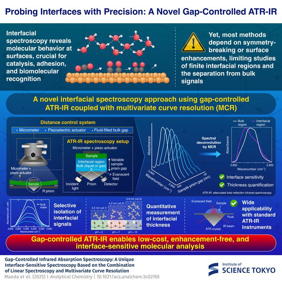Home > Press > Gap-controlled infrared absorption spectroscopy for analysis of molecular interfaces: Low-cost spectroscopic approach precisely analyzes interfacial molecular behavior using ATR-IR and advanced data analysis
 |
| Researchers have developed a low-cost method for the analysis of interfacial molecules by combining ATR-IR with precise gap-control and multi-variate data analysis.
Credit Institute of Science Tokyo |
Abstract:
A novel spectroscopic method developed at Institute of Science Tokyo, Japan, enables highly sensitive analysis of molecules at material interfaces, using a combination of conventional ATR-IR, precise gap-control and advanced data processing. The technique offers a low-cost alternative to conventional interfacial spectroscopy and has potential applications in material sciences, nanotechnology, and biological sciences.
Gap-controlled infrared absorption spectroscopy for analysis of molecular interfaces: Low-cost spectroscopic approach precisely analyzes interfacial molecular behavior using ATR-IR and advanced data analysis
Tokyo, Japan | Posted on October 3rd, 2025
Molecular interfacessuch as those found on solid surfaces, thin films, and liquid boundariesare central to countless processes in materials science, chemistry, and biology. These interfaces influence everything from the potential field in electrochemistry to the molecular interactions in proteins and cell membranes. But despite their importance, the study of these interfaces has remained a longstanding challenge. While some methods exist, conventional spectroscopic techniques usually fail, as the strong signals from the bulk material often overpower the subtle signals from the interface.
To address this limitation, a team of researchers from Institute of Science Tokyo (Science Tokyo), Japan, led by Associate Professor Tomohiro Hayashi from Department of Materials Science and Engineering, School of Materials and Chemical Technology, Science Tokyo, along with Graduate Student Shoichi Maeda and Team Leader Takuo Tanaka of RIKEN, developed a novel yet accessible technique called Gap-Controlled Infrared Absorption Spectroscopy to analyze molecular interfaces. The findings of the study were published in the journal Analytical Chemistry on September 13, 2025.
The approach is based on a widely used spectroscopic method called attenuated total reflection infrared (ATR-IR) spectroscopy. In ATR-IR spectroscopy, a sample is brought into contact with an infrared-transparent crystal to generate a weak evanescent wave which is an electromagnetic wave that selectively probes molecules at or near the surface. However, in conventional ATR-IR, isolating the surface-specific information is often difficult due to background signals from the bulk material. To overcome this, the team introduced a distance-control mechanism to precisely control a nanometre-scale distance between the infrared crystal and the sample.
The nanometre-scale gap allows us to vary the contribution of interfacial molecules to the spectrum, explains Hayashi.
The researchers then applied multivariate curve resolution (MCR) to the resulting series of spectral data. MCR is a sophisticated data analysis approach that mathematically separates and extracts the spectra of pure components and their concentration changes from a mixed dataset of overlapping signals. In this way, the developed method effectively filters out the background noise coming from the bulk material and isolates the signals of the molecular interface.
The strength of this approach lies in its simplicity, says Hayashi. By building on ATR-IR, which is already widely available, we eliminate the need for expensive instruments or specialized techniques to study interfacial molecules.
Furthermore, to demonstrate the scope of their method, the researchers applied the developed approach to a diverse range of systems. These included the analysis of water molecules at the surfaces of self-assembled monolayers, quartz surfaces under different pH conditions, and even polystyrene, a material widely used in cell culture dishes. The results showed excellent agreement with two highly specialized and expensive interfacial techniques: sum frequency generation (SFG) spectroscopy and surface-enhanced infrared absorption spectroscopy (SEIRAS). This confirms that the developed gap-controlled method was not only reliable but also practical for a wide range of applications.
The implications of the research carry broad significance across multiple domains. As interfacial phenomena are central to many technologies ranging from material coatings to biomaterials and nanodevices, the accessibility of this gap-controlled ATR-IR technique could drive breakthroughs in these technologies. Additionally, since it does not rely on rare equipment or costly enhancements, it offers an affordable and attractive tool for many laboratories.
We believe that our technique will accelerate both fundamental research and industrial applications in surface science, nanotechnology, and materials engineering, concludes Hayashi.
Looking ahead, the researchers plan to refine this technique for real-time monitoring of dynamic interfacial processes. With its unique combination of sensitivity, simplicity, and scalability, this technique offers a promising tool for researchers, opening new avenues in the hidden world of molecular interfaces.
####
About Institute of Science Tokyo (Science Tokyo)
Institute of Science Tokyo (Science Tokyo) was established on October 1, 2024, following the merger between Tokyo Medical and Dental University (TMDU) and Tokyo Institute of Technology (Tokyo Tech), with the mission of Advancing science and human wellbeing to create value for and with society.
For more information, please click here
Contacts:
Hiromi Nishimura
Institute of Science Tokyo (Science Tokyo)
Copyright © Institute of Science Tokyo (Science Tokyo)
If you have a comment, please Contact us.
Issuers of news releases, not 7th Wave, Inc. or Nanotechnology Now, are solely responsible for the accuracy of the content.
News and information
![]()
Researchers develop molecular qubits that communicate at telecom frequencies October 3rd, 2025
![]()
Next-generation quantum communication October 3rd, 2025
![]()
“Nanoreactor” cage uses visible light for catalytic and ultra-selective cross-cycloadditions October 3rd, 2025
Possible Futures
![]()
Spinel-type sulfide semiconductors to operate the next-generation LEDs and solar cells For solar-cell absorbers and green-LED source October 3rd, 2025
![]()
Researchers tackle the memory bottleneck stalling quantum computing October 3rd, 2025
Discoveries
![]()
Researchers develop molecular qubits that communicate at telecom frequencies October 3rd, 2025
![]()
Next-generation quantum communication October 3rd, 2025
![]()
“Nanoreactor” cage uses visible light for catalytic and ultra-selective cross-cycloadditions October 3rd, 2025
Announcements
![]()
Rice membrane extracts lithium from brines with greater speed, less waste October 3rd, 2025
![]()
Researchers develop molecular qubits that communicate at telecom frequencies October 3rd, 2025
![]()
Next-generation quantum communication October 3rd, 2025
![]()
“Nanoreactor” cage uses visible light for catalytic and ultra-selective cross-cycloadditions October 3rd, 2025
Interviews/Book Reviews/Essays/Reports/Podcasts/Journals/White papers/Posters
![]()
Spinel-type sulfide semiconductors to operate the next-generation LEDs and solar cells For solar-cell absorbers and green-LED source October 3rd, 2025
![]()
Rice membrane extracts lithium from brines with greater speed, less waste October 3rd, 2025
Tools
![]()
Japan launches fully domestically produced quantum computer: Expo visitors to experience quantum computing firsthand August 8th, 2025
![]()
Rice researchers harness gravity to create low-cost device for rapid cell analysis February 28th, 2025
![]()
New 2D multifractal tools delve into Pollock’s expressionism January 17th, 2025
Industrial
![]()
Quantum interference in molecule-surface collisions February 28th, 2025
![]()
Boron nitride nanotube fibers get real: Rice lab creates first heat-tolerant, stable fibers from wet-spinning process June 24th, 2022
![]()
Nanotubes: a promising solution for advanced rubber cables with 60% less conductive filler June 1st, 2022
![]()
Protective equipment with graphene nanotubes meets the strictest ESD safety standards March 25th, 2022










